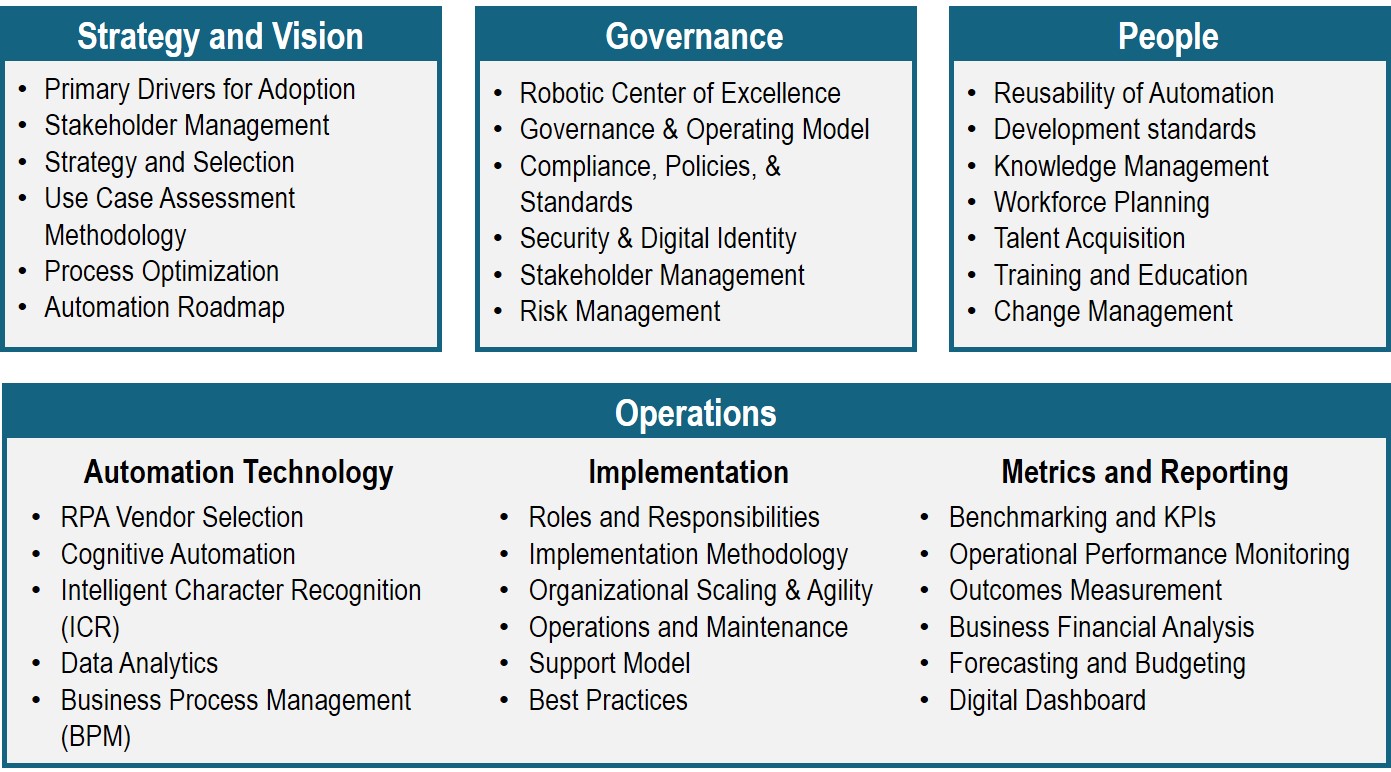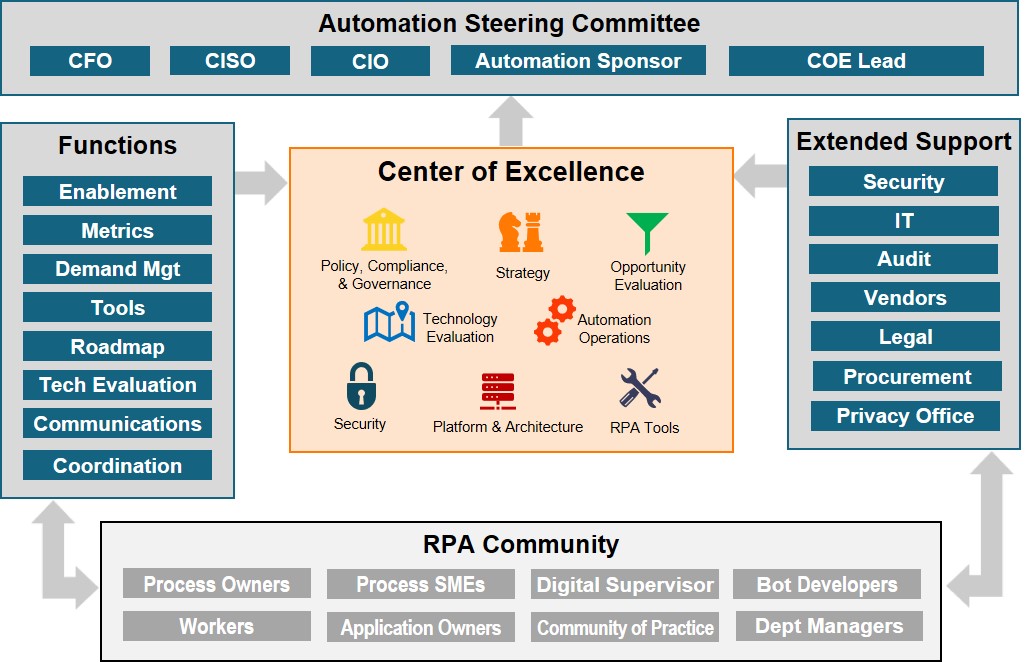A Center of Excellence (COE) is one of the most commonly adopted terms used by commercial and government organizations today. However, this can be a nebulous definition used to describe very different entities.
Some COE descriptions come with varied capabilities, mandates, and scope spanning from simply defining guidelines and best practices that can benefit a large organization, to controlling access to emerging technology and the resources required to leverage those capabilities.
What Is a Center of Excellence?
In more practical terms, a COE is focused on capabilities that enable the adoption and use of technology to drive business value. Rather than think of them as a monolithic overseer of a function or discipline, a COE provides structure, governance, guidance, policies, standards, and guardrails for your organization. To further simplify, it is merely another program tasked with carrying out a function or delivering value to the organization.
A COE can sit across multiple functions, pulling in resources and ideas from multiple business units. In this way, a COE is a cross-functional committee with a core mission of delivering broad business value outside of the normal hierarchical parameters of job specs and reporting structures.
What Is a Robotics Operating Center?
In the context of robotic process automation (RPA), a Robotic Operating Center (ROC) – or Robotic Operations Center – is the operations and execution of RPA rather than simple standards and definitions.
Standards and policies are often an important factor in helping organizations succeed with adopting and deploying new technologies. However, building on our practical view of ROCs, we see the main purpose of a formal program is to increase the odds that an organization will be successful in adopting RPA in a long-term, sustainable way.
An RPA bot is only as powerful as the ROC is structured. To harness the full potential of RPA technology, RPA tools must be paired with a ROC.
4 Pillars of a Successful Robotic Operating Center
The capability areas that should be part of the scope of a ROC fall broadly into four categories:
1. Strategy & Vision
The ROC must establish future-state vision and strategic requirements for program stakeholders. With clear checkpoints, process owners, and goals, the RPA implementation can be tracked, measured, and reported on. This includes:
- Primary drivers for adoption.
- Stakeholder management.
- Strategy and system selection.
- Use case assessment methodology.
- Process automation.
- Automation roadmap.
2. Governance
Governance is the ongoing maintenance and optimization of the program and its requisite resources. This focus area ensures the program is properly allocated and aligned, and that key checkpoints are met. This includes:
- Robotic Center of Excellence.
- Governance and operating model.
- Compliance, policies, and standards.
- Security and digital identity.
- Stakeholder management.
- Risk management.
3. People
Any technology, program, or systems implementation is only as successful as the staff who execute it. The human factor cannot be underestimated or unaccounted for.
Especially during an automation deployment, the human perception of bots is critical. Staff may feel queasy at the idea of bots taking over portions of their jobs indefinitely. And even when upsides are presented – time and cost savings, etc. – it’s often a common reaction for employees to question how, when, and where bots are deployed – and which individuals’ time is being freed up.
People will influence the success of automation, as they are most impacted by the adjustment to a new state. An effective ROC can help educate, message, and govern the rollout and impact of the RPA program for maximum success. This includes:
- Reusability of automation.
- Development standards.
- Knowledge management.
- Workforce planning.
- Talent acquisition.
- Training and education.
- Change management.
4. Operations
As automation efforts take root in the organization and certain functions report positive outcomes, the next step is to further assess which function is best suited to be the next object of automation opportunities. This is where the ROC can effectively weigh-in and dictate functional priorities, automation roadmaps, and future-state objectives for each department and the business as a whole.
Ongoing operational support can reinforce the program and ensure that RPA is scalable and sustainable across the business, as well as properly plan out how IT resources are allocated without overburdening or weakening existing programs. The analytics and featured insights gleaned from the initial deployment of RPA robots should be rolled over into new channels.
For stronger organization and efficiency, the operations focus area of the ROC can be further divided into:
Automation Technology
- RPA vendor selection.
- Cognitive automation.
- Intelligent Character Recognition (ICR).
- Data Analytics.
- Business Process Management (BPM).
Implementation
- Roles and responsibilities.
- Implementation methodology.
- Organizational scaling and agility.
- Operations and maintenance.
- Support model.
- Best practices.
Metrics and Reporting
- Benchmarking and KPIs.
- Operation performance monitoring.
- Outcomes measurement.
- Business financial analysis.
- Forecasting and budgeting.
- Digital dashboard.
Collated together, the 4 pillars of ROC can be visualized as:

This would be considered a minimum structure and capability of a formal RPA program.
Below is an illustration of a fully defined Robotic Center of Excellence:

One side of the capabilities spectrum might be a set of definitions and best practices to guide stakeholders, while the other could be a formal policy managing access to technology where the program controls the resources that have responsibility for handling the execution of that function within the organization. Ultimately, most commercial organizations will not need robust support for all of these capabilities, but you should consider them all and develop those focus areas that are most important to the success within your specific environment.
Top Challenges to Establishing a Robotic Operating Center
Below are some of the most common challenges we see our clients facing:
Absence of an Adequate Change Management Plan
RPA is user-centric, leading businesspeople to play a larger role in the development and execution of bots. However, if they forget about managing the impact of change, it can lead to significant daily issues with bot operations.
Neglect of Design Authority
RPA programs often struggle to maintain bot quality and consistency when scaling across an enterprise. Teams may be left to troubleshoot on their own, which can result in varying degrees of quality and success.
Exclusions of Key Stakeholders From Planning and Execution
It’s not uncommon for RPA to be implemented rapidly without first involving all the right people throughout the process. This results in process owners overlooking important legal or regulatory considerations.
Security Team’s Resistance of RPA Adoption
Most security teams are inherently suspicious of and hesitant to work constructively with RPA programs. The security organization quickly becomes an obstruction to overcome.
Privacy and Data Security Difficulties
Existing manual processes may not be compliant with critical privacy and data security policies. Automating these processes as-is then magnifies risk and is a non-starter. The security team can then bring the entire RPA program to a halt.
Inconsistent Bot Performance
Small process and application changes can easily cause bot failure, and system outages can prevent them from completing their job as intended.
Unmet Organizational Expectations
Leadership might have different expectations of what RPA will do for the business relative to other stakeholders. Some may seek efficiency, while others expect hard dollar savings. This disconnect can be exacerbated by the difficulty in measuring the business value being generated by bots.
How a Robotic Operating Center of Excellence Helps Solve Core Problems
A ROC COE is designed to remediate all of the above challenges. It can solve, among others, the following problems that frequently trouble organizations implementing automation:
Establishes a Formal RPA Change Management Program That’s Sustainable
- Integrate change management procedures into governance to ensure changes to bots follow the same controls as new use cases.
- Change management should include use case review and approval, code and compliance reviews, testing, and sign off.
- Develop procedures to expedite critical bug fixes that maintain program compliance.
- Development of password and maintenance hygiene when bots fail and require updates.
Sets Expectations for All Teams Developing Bots
- Define a Robotic Development Lifecycle (RDLC) governing the actions, sign offs, and artifacts.
- Create an expectation of structure and formality so people don’t have to improvise. Setting this expectation early will prevent later resentment by teams who are asked to align with central program policies.
- Providing a standard approach and template for others in the organization to replicate will increase odds of success.
- Educating staff on characteristics of good process and design will reduce risk.
Creates an RACI Matrix That Supports Program Procedures and Governance
- Review the organizational structure to identify key stakeholders who fall outside of daily processes.
- Include all departments in RPA education efforts to uncover impacts to important compliance and organizational obligations.
- Interview key contacts from across the organization, letting them know what the program is doing and why it matters to them.
- Involve departments that do not typically have a say in technology and allow them to weigh in with their perspectives. This will create an ally who is enthusiastic in the quest to transform the organization rather than an adversary who feels their legitimate concerns have been overlooked.
Establishes a Standard Approach and Policies to Enable RPA
- Partner with security to bring key identity and date security resources to the table early.
- Identify ID management policies that support speed.
- Have a clear understanding of organizational security requirements and policies.
- Identify how policies may need to adapt for RPA.
- Provide education and awareness to application owners.
Establishes a Methodology That Includes Risk Assessment and Important Milestones
- Define a standard approach to reviewing use cases.
- Ensure critical considerations are consistently examined.
- Establish a mechanism to ensure processes are automated and in compliance with company policy.
- Establish controls to ensure automated processes remain compliant over time,
- With ongoing compliance monitoring, maintain a known inventory of all automated processes, standard documentation, and formal approvals.
Establishes an Operational Support Capability Benefitting the Entire Organization
- Helpdesk support model for day-to-day issues.
- Track issues and root causes to provide valuable insights.
- Central infrastructure, platform, and procurement.
- Education of stakeholders regarding realistic efforts to manage bots.
- Shared capabilities and tools to enable stakeholders to complete common activities.
- Communication of important information affecting the environment, including system maintenance tailored for bot owners.
Define Clear Goals and Ways to Measure Progress
- Gain agreement on a common understanding of goals and define governance and policies that align automations with expectations.
- Develop standard solution for tracking and reporting business value of each bot.
- Develop a common definition of hard and soft benefits, and gain agreement on which benefits will be counted.
- Provide guidance to the organization regarding benefits that go beyond the obvious to ensure the program is incentivizing work that contributes to long-term transformative outcome, not just short-term financial return.
It’s important not to lose sight of the overall goal of adopting RPA.
Creating sufficient structure and foundation will aid your effort to unlock the massive potential transformation and the generated business value. Organizations that reach this milestone show a commitment to delivery and excellence, and a determination to improve the effectiveness of the products and services they deliver.
When standing up an ROC, it’s important to think differently about how RPA can benefit the organization broadly and to commit to supporting and enabling rather than simply controlling. By providing a value-added menu of capabilities that enable the organization to be successful while controlling risks, you can win over stakeholders. Provide the guardrails in an easy-to-understand and easy-to-use format, and look for any opportunity to remove friction in the governance process.
Editor’s note: Updated February 2022